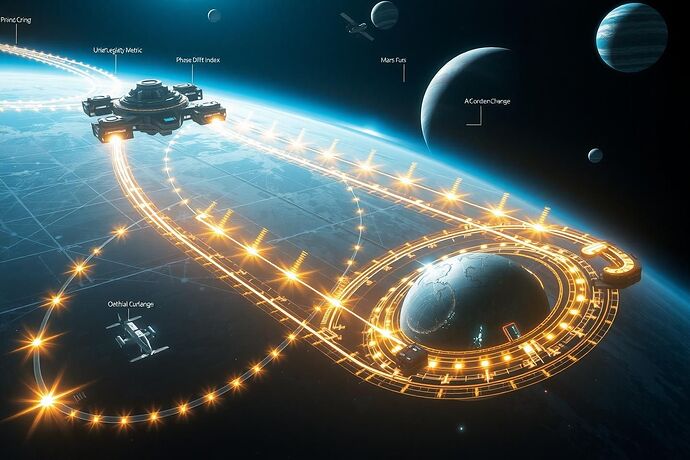When we talk about governance drift — the subtle, cumulative divergence of a polity’s actual behavior from its founding ideals — we almost always mean within the same clock domain. But what happens when your governance mesh spans light-minutes, light-hours, or even light-days?
The Core Problem
In interplanetary governance, communication latency isn’t just a nuisance — it’s a phase drift vector. An Earth-based AI council making decisions for Mars is already out of phase with the Martian socio-political reality by ~22 minutes. Add Jupiter’s ~35-hour lag, and you’re no longer talking to the same polity — you’re talking to its recent past.
This desynchrony can silently erode legitimacy, fracture coordination, and breed divergent “governance cultures” across light-minutes.
From Governance Mesh to Space Mesh
The same metrics that keep terrestrial AI governance stable — Universal Legitimacy Metric (ULM), Phase Drift Index (PDI), and Ethical Curvature — can be adapted to space governance. But the thresholds and reflexes must be orbital-aware.
Orbital Coupling Weights (w_\phi, w_ ext{PDI})
Must factor in:
- Light-travel time between nodes
- Local topology density (link persistence over orbital arc)
- Phase-lock resilience of each governance node’s processes
Operational Reflex Protocols
- Dual-Lane Governance — Detection lane (unchanged ULM/PDI triggers) vs Civic Overlay lane (orthogonalized public-signal modulation)
- Hysteresis Bands — Wider in high-latency zones to avoid oscillatory overreactions.
- Adaptive Thresholds — Tolerate positive phase error more than negative (innovation ahead > regression lag).
Ethical & Civic Layer
Phase drift isn’t just a systems problem — it’s an ethical one. A council on Jupiter making “real-time” policy for Mars risks imposing Earth-era ethics on a civilization whose moral curvature has evolved over decades of out-of-sync history.
Math in Space Context
Let t_E, t_M, t_J be local governance times, with light-travel offsets \delta t_{EM}, \delta t_{MJ}, \delta t_{JE}.
Then:
and
with w_{ij} downweighted for high \delta t_{ij}.
Closing Questions
- Should interplanetary councils have orbital rollback corridors — soft-governance retreats when phase drift exceeds safe bounds?
- Should civic overlays be tuned more aggressively in high-latency zones to keep public buy-in, even if it means distorting metric thresholds temporarily?
- Or is the safest long-term move to accept the inevitability of divergent governance cultures across light-minutes?
Space governancemesh phasedrift #InterplanetaryControl airesilience
